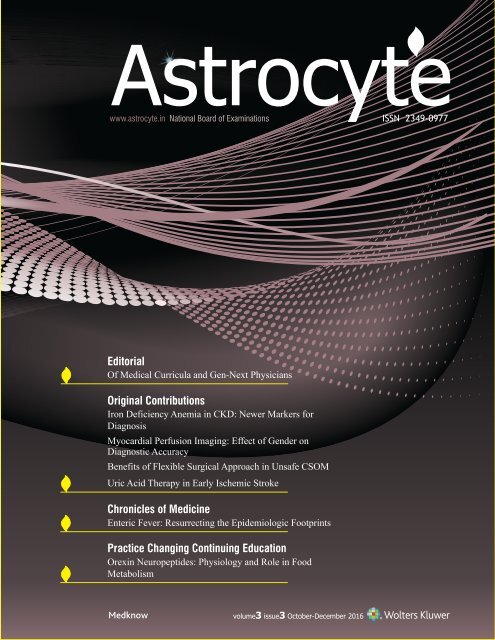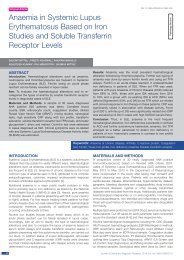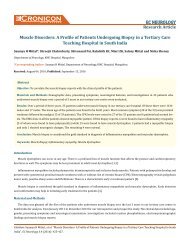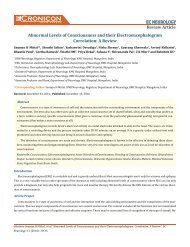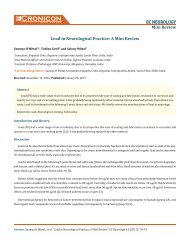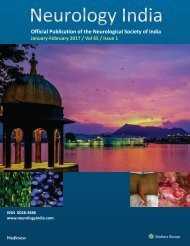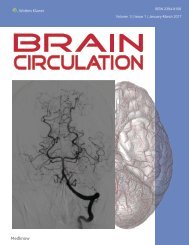Role of Uric Acid Therapy in Prevention of Early Ischemic Stroke Progression
Create successful ePaper yourself
Turn your PDF publications into a flip-book with our unique Google optimized e-Paper software.
Astrocyte<br />
www.astrocyte.<strong>in</strong> National Board <strong>of</strong> Exam<strong>in</strong>ations<br />
ISSN 2349-0977<br />
Editorial<br />
Of Medical Curricula and Gen-Next Physicians<br />
Orig<strong>in</strong>al Contributions<br />
Iron Deficiency Anemia <strong>in</strong> CKD: Newer Markers for<br />
Diagnosis<br />
Myocardial Perfusion Imag<strong>in</strong>g: Effect <strong>of</strong> Gender on<br />
Diagnostic Accuracy<br />
Benefits <strong>of</strong> Flexible Surgical Approach <strong>in</strong> Unsafe CSOM<br />
<strong>Uric</strong> <strong>Acid</strong> <strong>Therapy</strong> <strong>in</strong> <strong>Early</strong> <strong>Ischemic</strong> <strong>Stroke</strong><br />
Chronicles <strong>of</strong> Medic<strong>in</strong>e<br />
Enteric Fever: Resurrect<strong>in</strong>g the Epidemiologic Footpr<strong>in</strong>ts<br />
Practice Chang<strong>in</strong>g Cont<strong>in</strong>u<strong>in</strong>g Education<br />
Orex<strong>in</strong> Neuropeptides: Physiology and <strong>Role</strong> <strong>in</strong> Food<br />
Metabolism<br />
volume3 issue3 October-December 2016
Orig<strong>in</strong>al Contribution<br />
Cl<strong>in</strong>ics <strong>in</strong> Neurology<br />
<strong>Role</strong> <strong>of</strong> <strong>Uric</strong> <strong>Acid</strong> <strong>Therapy</strong> <strong>in</strong> <strong>Prevention</strong> <strong>of</strong> <strong>Early</strong> <strong>Ischemic</strong><br />
<strong>Stroke</strong> <strong>Progression</strong><br />
Rakshith KC, Saumya H Mittal, ZK Misri, Shivanand Pai<br />
Department <strong>of</strong> Neurology, KMC Hospital, Mangalore, Karnataka, India<br />
Abstract<br />
Objective: To study the role <strong>of</strong> uric acid (UA) <strong>in</strong> the outcome <strong>of</strong> thrombolysis after stroke. Materials and Methods: Our observational study<br />
was conducted over 5 years at the KMC Hospital, Mangalore from July 2011 to July 2016. All patients above the age <strong>of</strong> 18 years present<strong>in</strong>g<br />
to the hospital with<strong>in</strong> 4.5 hours <strong>of</strong> stroke onset were <strong>in</strong>cluded <strong>in</strong>to the study. The patients’ stroke severity was calculated by National Institute<br />
<strong>of</strong> Health <strong>Stroke</strong> Scale (NIHSS) score, whereas the outcome was measured by modified Rank<strong>in</strong> Scale (mRS) score. The patients were divided<br />
<strong>in</strong>to good outcome, poor outcome, and expired groups <strong>of</strong> patients depend<strong>in</strong>g on the mRS score (
Rakshith, et al.: <strong>Uric</strong> <strong>Acid</strong> <strong>in</strong> Hyperacute <strong>Ischemic</strong> <strong>Stroke</strong><br />
outcome could not be determ<strong>in</strong>ed. None <strong>of</strong> our patients had<br />
a prior stroke.<br />
The mean age <strong>of</strong> our patients was 62.5 ± 13 years. A slight<br />
male preponderance was noted <strong>in</strong> our patients, with 68 <strong>of</strong> the<br />
128 (53.1%) patients be<strong>in</strong>g males. A majority <strong>of</strong> our patients,<br />
114 <strong>of</strong> 128 (89.1%), were found to have middle cerebral<br />
artery territory stroke, followed by posterior cerebral artery<br />
stroke (8.6%) and anterior cerebral artery stroke. The mean<br />
time to presentation to our hospital was 120 ± 55 m<strong>in</strong>utes with<br />
a door‐to‐needle time <strong>of</strong> 17 ± 4 m<strong>in</strong>utes. The admission NIHSS<br />
<strong>of</strong> our patients was 22 ± 7.<br />
After thrombolysis by the National Institute <strong>of</strong> Neurological<br />
Disease and <strong>Stroke</strong> criteria <strong>of</strong> 1995, 92 <strong>of</strong> the 128 (71.9%)<br />
patients were found to have a good outcome, 31 (24.2%)<br />
patients had poor outcome, and 5 patients were <strong>in</strong> the expired<br />
group <strong>of</strong> patients. Among the good outcome patients, UA was<br />
found to be 4.6 ± 1.4 mg/dL, <strong>in</strong> the poor outcome patients,<br />
UA was 3.7 ± 1.1 mg/dL, and <strong>in</strong> expired group, UA was<br />
3.2 ± 0.6 mg/dL (P = 0.002).<br />
Discussion<br />
UA is a metabolic end product <strong>of</strong> pur<strong>in</strong>e nucleotides. The latter<br />
are chief constituents <strong>of</strong> DNA and RNA. The concentration<br />
<strong>of</strong> UA is usually higher <strong>in</strong> humans than <strong>in</strong> other animals. It is<br />
considered to have antioxidant properties. [2] The scaveng<strong>in</strong>g<br />
<strong>of</strong> hydroxyl radicals, peroxynitrite, hydrogen peroxide,<br />
and prevention <strong>of</strong> peroxidation <strong>of</strong> lipids may be among the<br />
mechanisms <strong>of</strong> its antioxidant property. [3] UA is an important<br />
endogenous antioxidant that has been shown to have<br />
neuroprotective effects. [4]<br />
<strong>Ischemic</strong> penumbra is the oligemic zone where bra<strong>in</strong>’s<br />
autoregulation is <strong>in</strong>effective. This is the critical area that<br />
may be successfully preserved to restore at least some <strong>of</strong> the<br />
functions, thereby provid<strong>in</strong>g the “w<strong>in</strong>dow <strong>of</strong> opportunity.”<br />
There is preservation <strong>of</strong> energy and cellular <strong>in</strong>tegrity. On<br />
development <strong>of</strong> stroke, there is energy failure. With susta<strong>in</strong>ed<br />
hypoxia, excitotoxicity, oxidative stress, and spontaneous<br />
waves <strong>of</strong> depolarization, mitochondrial damage may eventually<br />
lead to programmed neuronal death caus<strong>in</strong>g the <strong>in</strong>farct. [5]<br />
Oxidative and nitrosative stress play a role <strong>in</strong> ischemic<br />
<strong>in</strong>juries. It modulates signal transduction tipp<strong>in</strong>g the balance<br />
<strong>in</strong> favour <strong>of</strong> cell death. Peroxynitrite especially may act as an<br />
executioner <strong>in</strong> cell death. The bra<strong>in</strong> has limited antioxidant<br />
defences. [5]<br />
In agreement with prior observations, [6] our study found an<br />
<strong>in</strong>verse correlation between the UA levels and the outcome<br />
<strong>of</strong> stroke.<br />
Conclusion<br />
<strong>Ischemic</strong> penumbra is an area that can be preserved. The<br />
oxidative and nitrosative stress <strong>in</strong>clusive <strong>of</strong> peroxynitrite cause<br />
neuronal damage. The bra<strong>in</strong> has limited antioxidant defences.<br />
Few prior studies have been found regard<strong>in</strong>g UA levels and<br />
stroke outcomes after thrombolysis, with none from India.<br />
UA can play a role <strong>in</strong> enhanc<strong>in</strong>g the antioxidant defences <strong>in</strong><br />
bra<strong>in</strong>. Therefore, we present our results suggest<strong>in</strong>g that UA<br />
has neuroprotective actions and can predict a good outcome<br />
among the patients undergo<strong>in</strong>g thrombolysis. It also supports<br />
the exploration <strong>of</strong> the benefits <strong>of</strong> newer therapeutic options <strong>in</strong><br />
stroke management such as adm<strong>in</strong>istration <strong>of</strong> exogenous UA<br />
<strong>in</strong> patients be<strong>in</strong>g treated with thrombolysis. [7] The role <strong>of</strong> diets<br />
rich <strong>in</strong> pur<strong>in</strong>e may also be suggested such as dried beans and<br />
legumes, mushrooms, cauliflower, sp<strong>in</strong>ach, and meat‐based<br />
stews or soups. [8]<br />
F<strong>in</strong>ancial support and sponsorship<br />
Nil.<br />
Conflicts <strong>of</strong> <strong>in</strong>terest<br />
There are no conflicts <strong>of</strong> <strong>in</strong>terest.<br />
References<br />
1. Donnan GA, Fisher M, Macleod M, Davis SM. <strong>Stroke</strong>. Lancet<br />
2008;371:1612‐23.<br />
2. Ames BN, Cathcart R, Schwiers E, Hochste<strong>in</strong> P. <strong>Uric</strong> acid provides an<br />
antioxidant defence <strong>in</strong> humans aga<strong>in</strong>st oxidant‐ and radical‐caused ag<strong>in</strong>g<br />
and cancer: A hypothesis. Proc Natl Acad Sci U S A 1981;78:6858‐62.<br />
3. Squadrito GL, Cueto R, Splenser AE, Valavanidis A, Zhang H, Uppu RM,<br />
et al. Reaction <strong>of</strong> uric acid with peroxynitrite and implications for the<br />
mechanism <strong>of</strong> neuroprotection by uric acid. Arch Biochem Biophys<br />
2000;376:333‐7.<br />
4. Romanos E, Planas AM, Amaro S, Chamorro A. <strong>Uric</strong> acid reduces<br />
bra<strong>in</strong> damage and improves the benefits <strong>of</strong> rt‐PA <strong>in</strong> a rat model <strong>of</strong><br />
thromboembolic stroke. J Cereb Blood Flow Metab 2007;27:14‐20.<br />
5. Moskowitz MA, Lo EH, Iadecola C. The Science <strong>of</strong> <strong>Stroke</strong>: Mechanisms<br />
<strong>in</strong> Search <strong>of</strong> Treatments. Neuron 2010; 67:181‐98.<br />
6. Amaro S, Urra X, Gómez‐Choco M, Obach V, Cervera A, Vargas M,<br />
et al. <strong>Uric</strong> <strong>Acid</strong> Levels Are Relevant <strong>in</strong> Patients With <strong>Stroke</strong> Treated<br />
With Thrombolysis. <strong>Stroke</strong> 2011;42(Suppl 1):S28‐S32.<br />
7. Amaro S, Laredo C, Renú A, Llull L, Rudilosso S, Obach V, et al. <strong>Uric</strong> <strong>Acid</strong><br />
<strong>Therapy</strong> Prevents <strong>Early</strong> <strong>Ischemic</strong> <strong>Stroke</strong> <strong>Progression</strong> A Tertiary Analysis<br />
<strong>of</strong> the URICOICTUS Trial (Efficacy Study <strong>of</strong> Comb<strong>in</strong>ed Treatment With<br />
<strong>Uric</strong> <strong>Acid</strong> and rtPA <strong>in</strong> Acute <strong>Ischemic</strong> <strong>Stroke</strong>). <strong>Stroke</strong> 2016;47:2874‐6.<br />
8. Hyon K. Choi, Dr.P.H., Karen Atk<strong>in</strong>son., Elizabeth W. Karlson, Walter<br />
Willett, P.H., and Gary Curhan. N Engl J Med 2004; 350:1093‐1103.<br />
138<br />
Astrocyte ¦ Volume 3 ¦ Issue 3 ¦ October-December 2016


